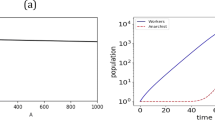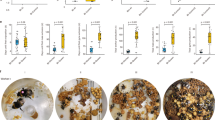Abstract.
Honey-bees, Apis, are an important model system for investigating the evolution and maintenance of worker sterility. The queen is the main reproductive in a colony. Workers cannot mate, but they can lay unfertilized eggs, which develop into males if reared. Worker reproduction, while common in queenless colonies, is rare in queenright colonies, despite the fact that workers are more related to their own sons than to those of the queen. Evidence that worker sterility is enforced by 'worker policing' is reviewed and worker policing is shown to be widespread in Apis. We then discuss a rare behavioural syndrome, 'anarchy', in which substantial worker production of males occurs in queenright colonies. The level of worker reproduction in these anarchic colonies is far greater than in a normal queenright honey-bee colony. Anarchy is a counterstrategy against worker policing and an example of a 'cheating' strategy invading a cooperative system.
Similar content being viewed by others
Author information
Authors and Affiliations
Additional information
Electronic Publication
Rights and permissions
About this article
Cite this article
Barron, A.B., Oldroyd, B.P. & Ratnieks, F.L. Worker reproduction in honey-bees (Apis) and the anarchic syndrome: a review. Behav Ecol Sociobiol 50, 199–208 (2001). https://doi.org/10.1007/s002650100362
Received:
Revised:
Accepted:
Issue Date:
DOI: https://doi.org/10.1007/s002650100362




